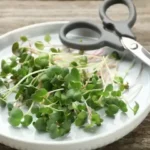With their increasing popularity, many people realize how nutritious and tasty microgreens are. But whether they are store-bought or homegrown, many growers want an answer to the age-old question: how long do microgreens last?
Store-bought microgreens last 5-7 days before spoiling because of several variable factors, such as packaging and transport, before reaching the shelf. Fortunately, homegrown microgreens can last as long as two weeks when stored correctly.
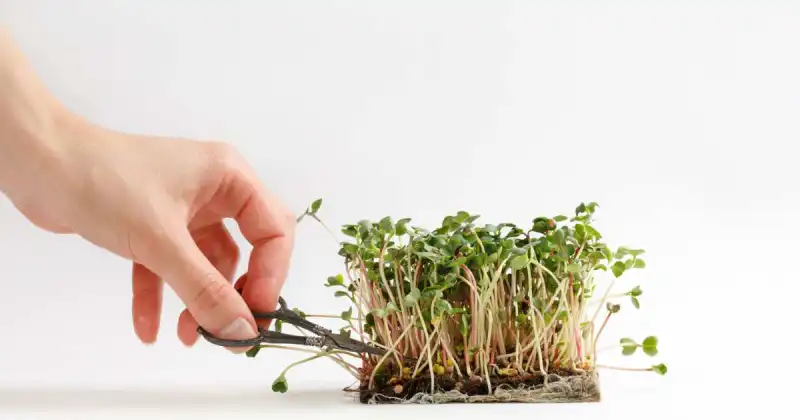
Interestingly, studies have shown that over half of Americans now consume more greens than just five years ago, making it clear why food companies invest heavily in fresh produce options like microgreens.
In this article, we’ll explore more about the shelf life of these intriguing greens and what you can do to keep them fresh for longer, whether you buy them or grow them yourself. I’ll also offer some tips when shopping for microgreens to ensure you get the freshest possible product.
By researching ahead of time and looking for signs of spoilage on the produce shelves, you can select the best microgreens available and maximize their shelf life once you bring them home to enjoy.
Humble Highlights
- Discover several popular varieties of microgreens that have both a longer shelf life and a shorter one so you can grow the greens best suited for your gardening goals!
- Save money by discovering these 4 unique and effective storage practices so you can extend the life of your harvested greens while keeping their nutrients and freshness.
- Stop wondering and understand these easy and practical steps to extend the life of your greens so you can offer your plants the best chance at longevity!
What Is The Shelf Life Of Microgreens
The shelf life of microgreens depends on several factors, including the type of microgreen, the method of storage, harvesting methods, and other environmental conditions. Microgreens can remain edible for up to two weeks after harvest with proper storage and handling techniques.

The first thing to understand about these miniature veggies is that they’re harvested much earlier than regular ones, like those found in the backyard garden. As such, it’s essential to know that these delicate greens have a shorter lifespan than mature vegetables. 1
Certain microgreens have a longer shelf life than the softer, more delicate varieties, and it is good to know which ones are likely to expire sooner to avoid waste.
More robust and less perishable microgreens include:
- Pea Shoots
- Sunflower
- Broccoli
- Kale
- Cabbage
Microgreens that typically have a shorter shelf-life include:
- Mustards
- Arugula
- Amaranth
Many factors impact how long microgreens last, such as how they are harvested and packaged, their storage temperature, and their exposure to light and moisture. Considering all these factors and providing optimal storage conditions will ultimately extend your greens’ freshness and shelf life.
How Long Do Store-Bought Microgreens Last
Store-bought microgreens typically last for 5 to 7 days as they need to be harvested, processed, and transported, all before they can be displayed on the shelves of your local supermarket for purchase. The process from harvest to sale can take up to a week, and the company considers this when printing “use-by” dates on the label.

While some prefer to purchase greens, others enjoy growing them at home due to their fresher taste and ease of growth. Either way, remember that store-bought microgreens will have a much shorter shelf life.
Because microgreens must be kept in optimal conditions throughout each processing stage, from harvesting to sale, any deviation may result in early degradation and shorter shelf life. Once microgreens have been purchased, further factors can cause these delicate greens to deteriorate further. 2
Generally, pre-packaged microgreen containers or bags should be refrigerated as soon as possible after purchase. However, if you cannot do this immediately due to transportation time, try to get them into the refrigerator within 4 hours of purchasing them from the store. Doing so helps maintain their quality and prevents unnecessary spoilage. Additionally, always use your greens within two days for the best results once opened.
Keeping these tiny greens cool and dry while avoiding light exposure can cause fading and wilting over time. To check for freshness, inspect your store-bought microgreens before consuming and look out for slimy texture or discoloration that may indicate spoiled produce.
How Long Do Homegrown Microgreens Last
Growing your microgreens is, without a doubt, the most cost-effective way to enjoy the full benefits of these nutrient-rich vegetables. Homegrown microgreens last much longer than store-bought varieties, often 14 to 20 days, if you adhere to proper storage, with some lasting as long as 30 days.
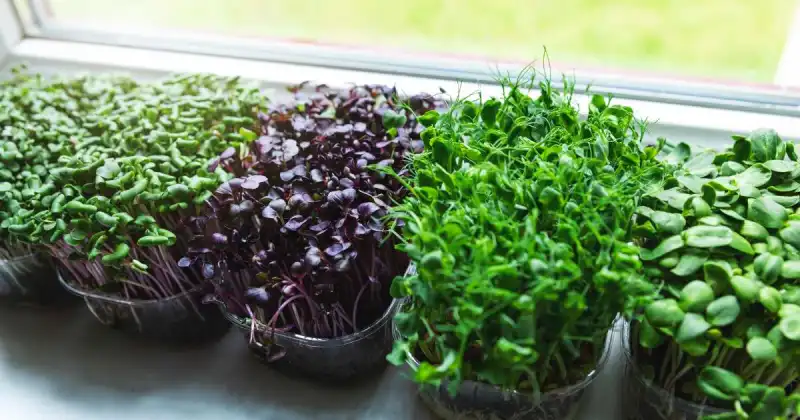
Growing microgreens at home offers you complete control of the entire process up to harvesting and storing them. Let’s look at some steps to store your microgreens effectively to increase their lifespan post-harvest. 3
Best Storage Practices
To get the longest possible shelf-life from your homegrown microgreens, you need to follow the correct steps from the time of harvesting through to packaging and storage.
1. Harvesting at the right time. For most varieties, microgreens should be harvested after the first true leaves appear. Microgreens still contain abundant nutrients before their true leaves sprout but are still very delicate. The longer you allow microgreens to grow, the hardier they become.
2. Harvesting in the right environment. Sunlight, temperature, and light are the three most damaging factors for microgreen degradation. Microgreens are most vulnerable when harvested as they lose access to their delicate root systems and nutrient supply. Always harvest your greens in a cool, moist environment to prevent pre-mature drying and dehydration of your plants.
3. Washing. It is essential to wash your homegrown microgreens, ensuring they are clean and safe to eat. Use a gentle stream of cold running water in a colander, or allow them to soak in a bowl of cold water for 10 minutes.
4. Drying. Properly drying your microgreens is imperative to maintain their freshness and longevity, as soggy microgreens will become soft and slimy and may attract mold.
The best way to dry your micros is by spreading them thinly on a paper towel so water can drain appropriately. Also, allow air to circulate around the freshly harvested crops with a small oscillating fan.
5. Packaging. Now that your microgreens are dry, you can package them for storage. You can use zip-lock bags or mason jars lined with paper towels that will help absorb excess water, while some people prefer to vacuum pack their microgreens. Airtight containers are best as they help prevent bacteria such as E.coli and Salmonella from growing.
6. Storage. Storing microgreens is essential to prolong their shelf-life. Microgreens stored above freezing and below 4°C (39°F), while kept away from sunlight or other strong light sources, typically last the longest. This storage process makes a refrigerator the ideal place to keep your microgreens. However, any cool, moisture-free environment will do. 4
Knowing how long homemade microgreens last allows you to plan accordingly, minimizing waste while being mindful of food safety protocols. Next, let’s look at some key indications that can alert you when your greens have gone bad and must be discarded.
How Long Do Microgreens Last In The Fridge
Microgreens stored in a fridge typically last until their expiry date on the packaging. Conversely, fresh, homegrown microgreens usually last up to 14 days or longer if packaged correctly.
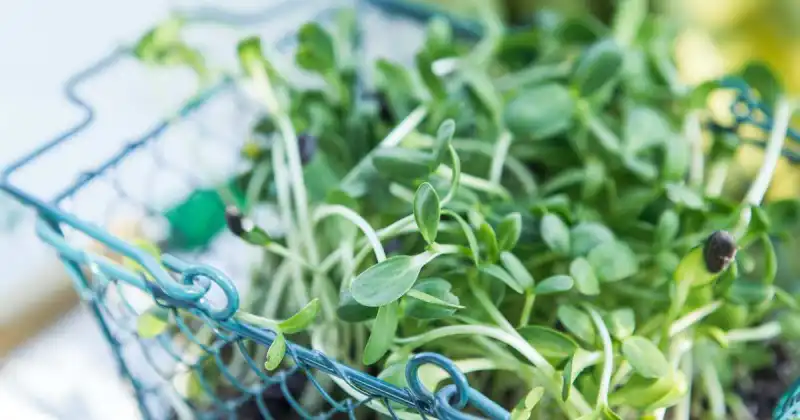
Ensure your refrigerator temperature is within the recommended range for microgreen storage of 0°C to 4°C. However, you can store microgreens anywhere dry and within this optimal temperature range with the same beneficial result. 5
Remember, with proper care and attention, you too can confidently enjoy your store-bought or homegrown microgreens and significantly extend their shelf life while still knowing they are still fresh and packed with nutrients. The video below explains that even though you may not be selling your microgreens commercially, you can still choose quality when packaging and storing your greens.
How To Tell If Microgreens Are Bad
Whether you have bought packaged microgreens with a use-by date or grown your own, many factors affect their freshness. Therefore, it’s critical to determine when your greens go bad and should be discarded rather than consumed.
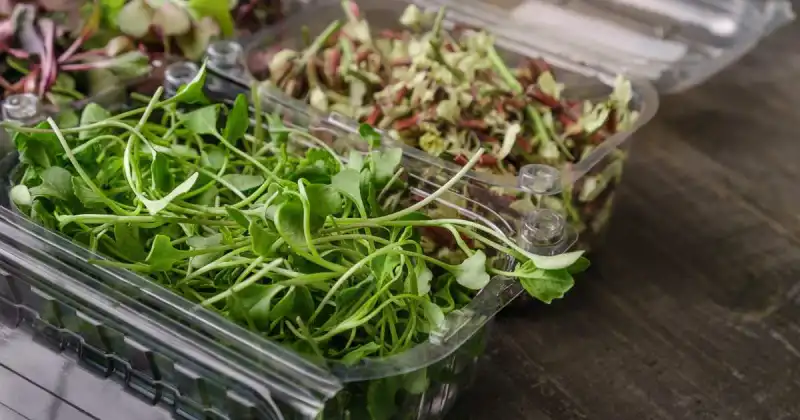
There are four primary ways to tell if microgreens are bad.
1. Appearance. Discoloration of microgreens leaves indicates that your plants are likely past their prime. Look for leaves turning brown or yellow. 6
2. Smell. Microgreens should smell fresh. If they smell otherwise, discard them immediately if you notice a bad odor, usually caused by excess bacteria.
3. Feel the leafy texture. Fresh greens will be firm and crisp, while wilted leaves indicate spoilage. Slimy leaves are another sign that usually happens when microgreens are packaged wet or spoiled within their package. Also, check for mold growth.
4. Taste. Although not the best or first way you’ll want to determine if your greens have become blemished, tasting your micros is a surefire way of telling if your greens have spoiled, as any bitterness or sourness indicates they’ve expired. Completely avoid tasting your micros and immediately discard them if you notice mold growth, slimy texture, bad smell, or foliage discoloration.
It’s important to remember that microgreens are highly perishable, requiring proper storage to maintain quality. Because microgreens are often eaten raw, it’s essential to be aware of the potential for bacteria growth that can lead to food poisoning, normally avoided through cooking.
If purchasing your greens, remember that use-by dates are only reliable if your microgreens are stored perfectly from their packaging date. Retailers should follow strict storage guidelines for all perishable products, but nothing is guaranteed.
How Do You Make Microgreens Last Longer
Following sanitary and proper storage practices is the best way to prolong the life of microgreens. To make your microgreens last even longer, follow these top suggestions:
- Minimize Moisture In The Bag
- Store At A Constant Temperature
- Partially Harvest Your Microgreens
- Harvest Microgreens In A Cool Environment
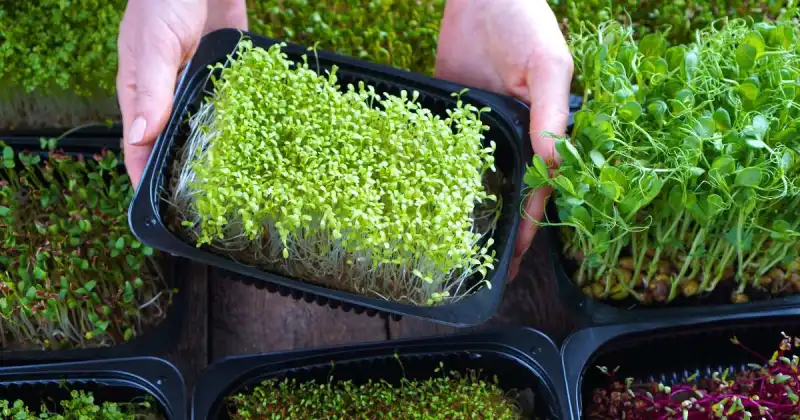
Let’s look at each of these main points more closely below.
Minimize Moisture In The Bag
Regularly check the moisture level in the package, as you should remove condensation on the inside surface immediately with a dry cloth or paper towel.
Remember, excess moisture encourages bacterial growth and reduces shelf life significantly. Remove any leaves from the package to avoid further spoilage if you notice any leaves becoming moist and slimy.
Store At A Constant Temperature
Microgreens won’t last as long when repeatedly exposed to warm and then cold temperatures. If you store your microgreens in the fridge, keep them in an area away from the door, ideally in the salad and vegetable compartments. This simple act helps protect your microgreens from the warm air entering your fridge each time the door opens and the temperature swings that occur as a result. 7
Finally, don’t assume you are safe by placing your microgreens at the back of your fridge, as this is the coldest part. Without adequate airflow, your microgreens could freeze, reducing their shelf-life and freshness.

If you store fruit and vegetables in your fridge, be aware that they give off their own heat as they ripen. So, keeping them separate and away from your microgreens is best.
Partially Harvest Your Microgreens
Microgreens can be harvested at any point from their cotyledon leaf growth until just after producing their true leaves. To maximize the shelf-life of your micro crop, start harvesting slightly earlier (a day or two) than you would usually and only harvest what you intend to use. 8
While your microgreen crop grows in soil or other alternative mediums like coco coir, it remains fresh. If you have already consumed half the crop when it becomes fully mature and you are forced to harvest the rest, there may be less to consume before it goes bad, so plan accordingly.
Harvest Microgreens In A Cool Environment
Microgreens last longest when kept in cool temperatures as it affects something called respiration rate. Plant respiration occurs when small pores (stomata) absorb oxygen, which the plant’s cells use to dissolve glucose into water and outgas carbon dioxide. As temperatures warm, higher respiration rates occur, which leads to faster degradation. 9
This process also occurs at harvesting time, so it’s advisable to harvest your microgreen crop in a cool environment, and as close to the temperature it will be stored to ensure the longest lifespan. If you cultivate your microgreens outside, the best harvest time is early morning or evening.
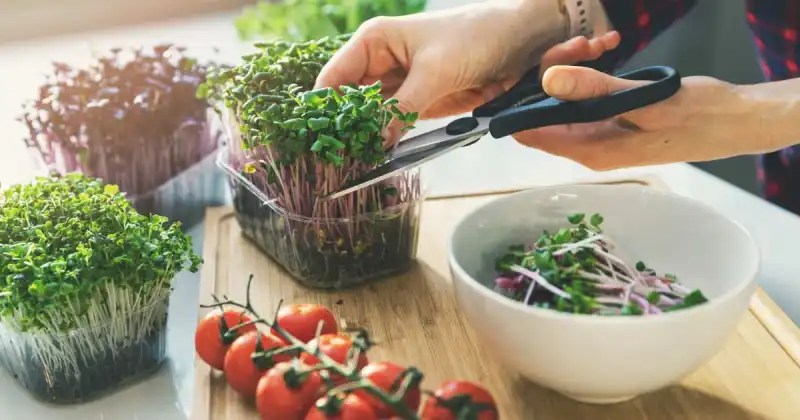
Conclusion
Microgreens are full of goodness and packed with nutrients, but this is only true when consumed fresh. Microgreens are young, delicate versions of more mature vegetables in your backyard garden, making these tiny greens fragile and highly perishable.
Despite their short shelf life, microgreens can last up to two weeks when stored correctly. On average, store-bought microgreens will only last around seven days, depending on harvesting, shipping, and storage techniques. Homegrown microgreens last significantly longer, and you have much more control over the entire process, from harvesting to packaging.
As with all produce, it’s essential to check for signs of spoilage before consuming, as the sooner you spot any bad spots or wilting leaves, the better. Some simple strategies can help make your microgreens last even longer, such as refrigerating them in an airtight container with paper towels to remove excess moisture.
Microgreens are very easy and cheap to grow, so I highly recommend growing your crop to get them at their freshest, and they will last much longer.
What methods do you use to store your homegrown microgreens that help them last longer? We’d love to know! Take a moment now, and drop us a line in the comment section below to connect with your fellow gardeners!
SOURCES
- MDPI – Antioxidant Capacity And Shelf Life Of Radish Microgreens Affected By Growth Light And Cultivars
- Penn State University, Extension – Growing Microgreens
- Wikipedia – Microgreen
- MDPI – Effects Of Storage Temperature, Packaging Material And Wash Treatment On Quality And Shelf Life Of Tartary Buckwheat Microgreens
- United States Food & Drug Administration – Program Information Manual Retail Food Protection: Recommendations For The Temperature Control Of Cut Leafy Greens During Storage And Display In Retail Food Establishments
- United States Food & Drug Administration – Standards For The Growing, Harvesting, Packing, And Holding Of Produce For Human Consumption: Guidance For Industry
- United States Department Of Agriculture – Specialty Greens Pack A Nutritional Punch
- University Of Nevada, Reno Extension – Microgreens And Produce Safety
- National Library Of Medicine, National Center For Biotechnology Information – Plant Respiration And Elevated Atmospheric CO2 Concentration: Cellular Responses And Global Significance


